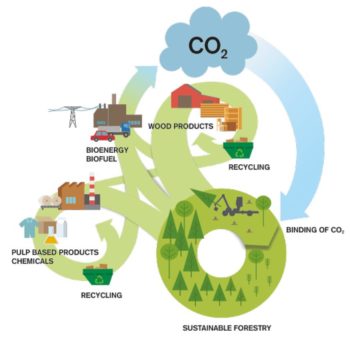Energy from woody biomass can be very positive for the climate, particularly when applying sustainable forest management practices, and when the biomass is used efficiently (such as in combined heat and power plants and biorefineries). link to the full brief: FAQ_WoodyBiomass-Climate_final 
The scientific literature contains contrasting findings about the climate effects of forest bioenergy, partly due to the wide diversity of bioenergy systems, but also due to differences in assessment methods. Scientists involved in IEA Bioenergy recently published a scientific paper in the Journal GCB Bioenergy “Applying a science- based systems perspective to dispel misconceptions about climate effects of forest bioenergy“. The paper examines debated aspects related to climate impacts of forest bioenergy, in applications including heat production, electricity generation and transport. It identifies factors that are relevant to understanding the climate effects of forest bioenergy, and misconceptions that can lead to conclusions that exaggerate or underestimate the effects. The objective is to reduce confusion arising from publication of diverging studies on forest bioenergy, to inform policy development, business decisions and the public debate on bioenergy. The paper is available here: https://www.ieabioenergy.com/blog/publications/applying-a-science-based-systems-perspective-to-dispel-misconceptions-about-climate-effects-of-forest-bioenergy/.
Considering the crucial role of forests to the climate and many other ecosystem services, sustainable forest management is key to maintaining healthy and productive forests, and for controlling harvest levels so as to maintain or increase carbon stocks in forests*. Within this overall framework, efforts to increase global forest area through reforestation and afforestation, and management strategies aimed at maintaining or increasing carbon stocks, while also producing an annual sustained yield of timber, fibre and energy from forests are very important for climate change mitigation; these strategies contribute to replacing carbon-intensive materials and fossil fuels, which is crucial in future decarbonisation strategies. Most woody biomass sourced for energy is a by-product or residue of forestry operations and forest industry. Examples from forest management include thinnings, diseased or low quality trees, tops and branches; examples from forest industry include shavings, sawdust, bark and black liquor. Generally, the primary forest sector aim is to produce high value products, such as sawnwood and wood panels, or pulp and paper. Using by-products and residues for energy has typically been found to achieve climate change mitigation benefits in the short term. It is not recommended to use long-rotation high quality stemwood for energy**, or cutting entire forests to generate bioenergy. Nevertheless, lower-value roundwood from short rotation forestry, thinnings, diseased or low quality trees should not be excluded.
Fossil vs biogenic CO2 emissions
Some people are puzzled about how bioenergy can contribute to climate change mitigation because burning biomass emits carbon dioxide (CO2). Read more …
Bioenergy is commonly said to be “carbon neutral”, but this is an unhelpful term because it is ambiguous, and used differently in different contexts. Read more …
Timing of greenhouse gas emissions
Another important issue which is often raised is the asynchrony between the timing of emissions and sequestration, particularly when biomass is obtained from long rotation forests, where a stand takes decades to regrow. Read more …
Forest management and market responses
Biomass extraction for energy is one of many interacting factors influencing the development of forest carbon stocks. Read more …
* Sustainable forestry is vital for many reasons – also from a carbon balance perspective. Valuable forests need to be protected and forestry methods in production forests need to be sustainable. To determine whether a forest system is managed sustainably requires consideration of a wide range of factors, which together determine a forest’s biodiversity, productivity, regeneration capacity, vitality and potential to fulfil relevant ecological, economic and social functions. Considerations beyond climate effects of woody biomass use for energy are however outside the scope of this FAQ. ** In practice, high quality stemwood is not used for bioenergy on a significant scale, because the paying capacity of saw mills and other users of high quality stemwood is much higher than prices that can be paid by the bioenergy industry, even when taking current subsidy levels for bioenergy into account. Further reading:
-
Cowie AL, Berndes G, Bentsen NS, et al. Applying a science- based systems perspective to dispel misconceptions about climate effects of forest bioenergy. GCB Bioenergy. 2021;00:1–22. https://doi.org/10.1111/gcbb.12844
-
Cowie A, Brandão M (2017): IEA Bioenergy Task 38 – Climate change effects of biomass and bioenergy systems. Article in IEA Bioenergy News Vol 29, Number 2, December 2017.
- Bioenergy: Is it good for the climate? Annette Cowie, webinar presentation, 21 April 2016 https://www.ieabioenergy.com/wp-content/uploads/2016/01/Bioenergy-is-it-good-for-the-climate-A-Cowie_IEA-Bioenergy-webinar-21Apr2-16.pdf
- IEA Bioenergy (2017): Response to Chatham House report “Woody Biomass for Power and Heat: Impacts on the Global Climate” https://www.ieabioenergy.com/wp-content/uploads/2017/03/Chatham_House_response_supporting-doc.pdf
- IEA Bioenergy (2013): On the timing of greenhouse gas mitigation benefits of forest-based bioenergy https://www.ieabioenergy.com/wp-content/uploads/2013/10/On-the-Timing-of-Greenhouse-Gas-Mitigation-Benefits-of-Forest-Based-Bioenergy.pdf
- European Forest Institute (2016): Forest biomass, carbon neutrality and climate change mitigation. http://www.efi.int/files/attachments/publications/efi_fstp_3_2016.pdf
- IEA Bioenergy Task 38 (2013): Answers to ten frequently asked questions about bioenergy, carbon sinks and their role in global climate change https://www.ieabioenergy.com/wp-content/uploads/2013/10/13_task38faq.pdf
- IPCC assessment report 5, chapter 11: Forestry (2014) https://www.ipcc.ch/pdf/assessment-report/ar5/wg3/ipcc_wg3_ar5_full.pdf
- Cintas O, Berndes G, Cowie AL, (…), Marland G, Ågren GI (2017): Carbon balances of bioenergy systems using biomass from forests managed with long rotations: bridging the gap between stand and landscape assessments, 2017, GCB Bioenergy 9 (7), pp. 1238-1251. http://itp-sustainable.ieabioenergy.com/wp-content/uploads/2017/11/Cintas.-Carbon-balances-of-bioenergy-systems-using-biomass.pdf
- Koponen K, Soimakallio S, Kline KL, Cowie A, Brandão M (2017): Quantifying the climate effects of bioenergy – Choice of reference system, 2017, Renewable and Sustainable Energy Reviews. http://itp-sustainable.ieabioenergy.com/wp-content/uploads/2017/11/Koponen.-Quantifying-the-climate-effects-of-bioenergy-–-Choice-of-reference-system.pdf
- Dale VH, Parish ES, Kline KL, Tobin E (2017): How is wood-based pellet production affecting forest conditions in the southeastern United States? Forest Ecology and Management 396: 143-149. http://dx.doi.org/10.1016/j.foreco.2017.03.022
- Duden AS, PA Verweij, HM Junginger, RC Abt, JD Henderson, VH Dale, KL Kline, D Karssenberg, JA Verstegen, APC Faaij, F van der Hilst (2017): Modelling the impacts of wood pellet demand on forest dynamics in southeastern United States. Biofuels, Bioproducts and Biorefining. http://itp-sustainable.ieabioenergy.com/wp-content/uploads/2017/11/Duden-et-al.-Modeling-the-impacts-of-wood-pellet-demand-on-forest-dynamics-in-southeastern-United-States.pdf
- Hanssen SV, Duden AS, Junginger HM, Dale VH, van der Hilst F (2017): Wood pellets, what else? Greenhouse gas parity times of European electricity from wood pellets that are produced in the south-eastern United States using different softwood feedstocks. GCB Bioenergy. DOI: 10.1111/gcbb.12426. http://itp-sustainable.ieabioenergy.com/wp-content/uploads/2017/11/Hanssen.-Wood-pellets-what-else-Greenhouse-gas-parity-times-of-European-electricity-from-wood-pellets-SE-US.pdf
- Parish ES, Dale VH, Kline KL Abt RC (2017): Reference scenarios for evaluating wood pellet production in the Southeastern United States. WIREs Energy and Environment. e259. doi: 10.1002/wene.259. http://itp-sustainable.ieabioenergy.com/wp-content/uploads/2017/11/Parish-et-al.-Reference-scenarios-for-evaluatingwood-pellet-production-in-SE-US.pdf
Last editing: January 15, 2018


